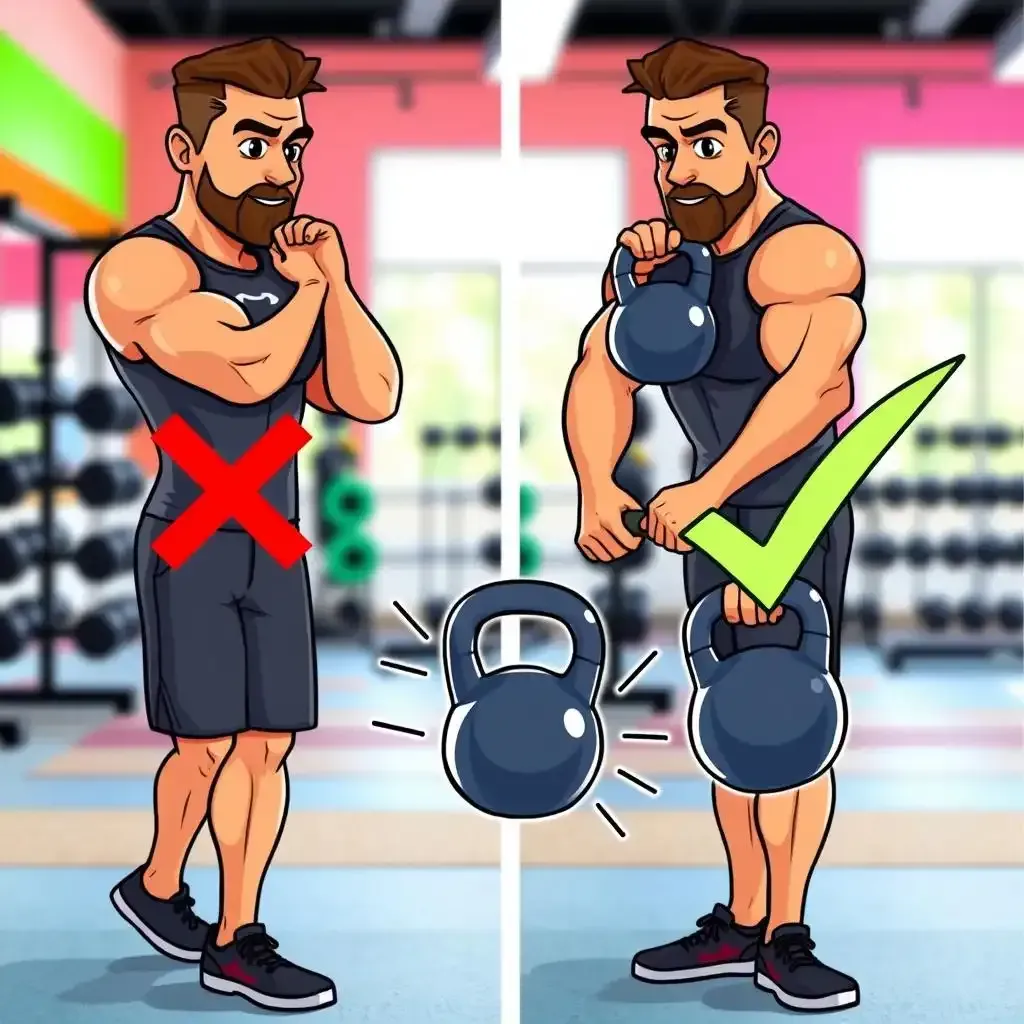Table of Contents
Welcome to the world of kettlebells! Whether you're a seasoned athlete or a fitness newbie, kettlebells offer a versatile and effective way to build strength, increase flexibility, and improve overall fitness. However, mastering the kettlebell technique is crucial to getting the most out of your workout while minimizing the risk of injury. At kettlebellworkout.homes, we're committed to helping you achieve your fitness goals, and that's why we've put together this comprehensive guide to kettlebell technique tips. In this article, we'll cover the essential techniques, common mistakes to avoid, and advanced tips to take your kettlebell workout to the next level. So, what are you waiting for? Let's investigate into the world of kettlebells and access your full potential!
Mastering the Basics: Essential Kettlebell Technique Tips

Mastering The Basics Essential Kettlebell Technique Tips
Start with the Right Stance
One of the first things you need to do when using a kettlebell is to get your stance right. Think of it like setting up for a sprint. Your feet should be shoulder-width apart, and you should be standing on the balls of your feet. This gives you a solid base and allows you to generate strength from your legs. It’s not just about lifting the weight; it’s about moving with control and stability.
Imagine you're a tree rooted firmly in the ground. Your feet are the roots, and your legs are the trunk. This analogy helps you visualize how to distribute your weight and maintain balance. A strong foundation is key to avoiding injuries and getting the most out of your kettlebell workout. If you need more tips on standing form, check out our kettlebell basics guide.
Stance Tip | Description |
|---|---|
Feet Position | Shoulder-width apart, on the balls of your feet |
Weight Distribution | Evenly distributed, with a slight bend in the knees |
Core Engagement | Keep your core tight to maintain stability |
Grasp and Grip: The Heart of the Swing
The way you grip the kettlebell is crucial. Hold the kettlebell with both hands, using a firm but not death grip. Your hands should be wrapped around the handle, with your thumbs pointing forward. This grip allows you to maintain control while also reducing the risk of the kettlebell slipping out of your hands. It’s like holding a steering wheel in a car—you need a firm grip to steer safely.
A common mistake is to grip the kettlebell too tightly, which can lead to tension in your wrists and forearms. Instead, think of your grip as a balance between firm and relaxed. Imagine you’re holding a live fish; you don’t want it to slip away, but you also don’t want to crush it. For more grip strength tips, check out our grip strength guide.
- Firm but not tight
- Wraps around the handle
- Thumbs pointing forward
- Balance between firm and relaxed
Perfecting Form: Advanced Kettlebell Technique Tips for Capability and Precision

Perfecting Form Advanced Kettlebell Technique Tips For Capability And Precision
The Strength of the Hip Hinge
Okay, so you've nailed the basics – congrats! Now let's talk about really *owning* that kettlebell. The hip hinge is where the magic happens. It's not just about bending over; it's a controlled movement that starts in your hips, keeping your back straight as a ruler. Think of it like a hinge on a door – your hips are the hinge, and your upper body should move as one unit. You're loading up strength in your hips, not your back. This is super important to avoid injury. I once saw someone try a kettlebell swing with their back all hunched – it looked like a question mark with weights! Don't be that person. Practice your hip hinge in front of a mirror until it feels natural. It takes time, but trust me, it's worth it. Check out our for more info.
- Start with a neutral spine.
- Hinge at the hips, not the waist.
- Maintain a flat back.
- Keep your chest up.
Breathing and Tension: The Unsung Heroes
Breathing? In a kettlebell workout? Yep! It's not just about getting air into your lungs; it's about controlling your body tension. When you're swinging that kettlebell, breathe out powerfully as you drive through your hips. It helps you generate more force, and it helps to keep your core stable. Think of it like blowing up a balloon – you exert force from your core. And remember, don't clench up like a pretzel! Relax your shoulders and neck. Tension is the enemy of good form. It robs you of strength and increases your risk of injury. If you're struggling with tension, try some of the breathing exercises on our breathing techniques page. It’s all about finding that sweet spot between capability and control.
Breathing Phase | Action |
|---|---|
Inhale | Before the movement; deep and controlled |
Exhale | During the strength phase; forceful and controlled |
Common Mistakes to Avoid: Troubleshooting Your Kettlebell Technique

Common Mistakes To Avoid Troubleshooting Your Kettlebell Technique
Swaying and Swaying Movements
When doing kettlebell swings, clean and presses, or any other movement that involves the kettlebell, make sure to maintain a stable base and avoid excessive swaying. If you're new to kettlebell training, you might find yourself swaying back and forth, which can put unnecessary strain on your lower back. Instead, keep your core engaged and focus on generating strength from your hips and legs. for more tips on proper form.
One way to avoid swaying is to imagine you're holding onto a rope or a bar, and you need to stabilize your body to maintain your grip. This will help you stay focused and keep your movements controlled. Remember, the kettlebell should be an extension of your body, not the other way around.
Types of Swaying Movements | Corrections |
|---|---|
Excessive back arching | Engage your core and maintain a neutral spine |
Swinging the kettlebell too high | Keep the kettlebell at hip or chest level |
Letting the kettlebell swing too far back | Keep the kettlebell close to your body and control the swing |
Twisting and Rotating Movements
When performing kettlebell movements, avoid twisting or rotating your torso unnecessarily. Instead, focus on rotating your hips and legs to generate ability. Twisting can put unnecessary strain on your spine and lead to injury. Check out our kettlebell workout tips for more advice on proper form.
One way to avoid twisting is to imagine you're holding onto a fixed point, and you need to rotate around it while keeping your core engaged. This will help you maintain a stable base and generate capability from the right sources.
- Twisting can lead to lower back strain and injury
- Rotating your hips and legs generates ability and control
- Keep your core engaged to maintain stability
Incorporating Kettlebell Technique Tips into Your Workout Routine

Incorporating Kettlebell Technique Tips Into Your Workout Routine
So, you've learned the moves, you're feeling confident – fantastic! Now it's time to integrate these awesome kettlebell techniques into your regular workouts. Don't just throw kettlebells into your routine randomly; think of it like adding a super cool new spice to your favorite dish. You wouldn't just dump it in, right? You'd add it carefully, tasting as you go. Same thing with kettlebells. Start slow. Maybe add one or two kettlebell exercises to a routine you already enjoy. For instance, if you already love a good cardio session, add a few kettlebell swings in between sets of burpees or jumping jacks. It's a great way to boost your workout's intensity and challenge your muscles in new ways.
Remember those beginner routines I mentioned earlier? They're your best friends here. Check out our beginner kettlebell workouts to get started. It's all about building a strong foundation before you start adding more challenging exercises. Remember, consistency is key! It's better to do a few exercises correctly than to try and do too much too soon and risk injury. We've got tons of resources to help you – seriously, check out our starter kettlebell exercises page for some simple, effective routines.
- Start slowly, adding kettlebell exercises gradually.
- Use existing workout routines as a base.
- Focus on proper form over quantity.
- Listen to your body and take rest days when needed.
Once you feel comfy with a few basic exercises, you can slowly add more complex moves. Think of it like learning to ride a bike – you start with training wheels (basic exercises), then gradually remove them as you gain confidence (more advanced moves). But always keep that perfect form in mind! Remember, you're not just lifting weights; you're building strength, improving balance, and sculpting your physique. It's a progression, not a race. So, take your time, be patient, and enjoy the process. And if you're feeling stuck, check out our kettlebell workout plans for some structured routines.
Don't be afraid to experiment! Try different combinations of exercises, focusing on different muscle groups. You might learn your own favorite kettlebell workout routine! It's all about finding what works best for you and your body. Remember, consistency is more important than intensity. If you're struggling to stay motivated, find a workout buddy or join a kettlebell class – having someone to workout with can make all the difference. For some more ideas, take a peek at our easy kettlebell exercises page.
Workout Day | Exercises | Sets | Reps |
|---|---|---|---|
Monday | Kettlebell Swings, Goblet Squats | 3 | 10-12 |
Wednesday | Kettlebell Rows, Turkish Get-Ups | 3 | 8-10 |
Friday | Kettlebell Clean & Press, Kettlebell Deadlifts | 3 | 6-8 |
Final Thought
Mastering the kettlebell technique takes time and practice, but with patience, dedication, and the right guidance, you can open up a world of fitness possibilities. By incorporating these kettlebell technique tips into your workout routine, you'll be able to achieve a stronger, leaner, and healthier you. Remember, the key to successful kettlebell training is to focus on proper form, consistency, and progressive overload. So, stay committed, stay focused, and get ready to swing your way to a fitter, healthier you!